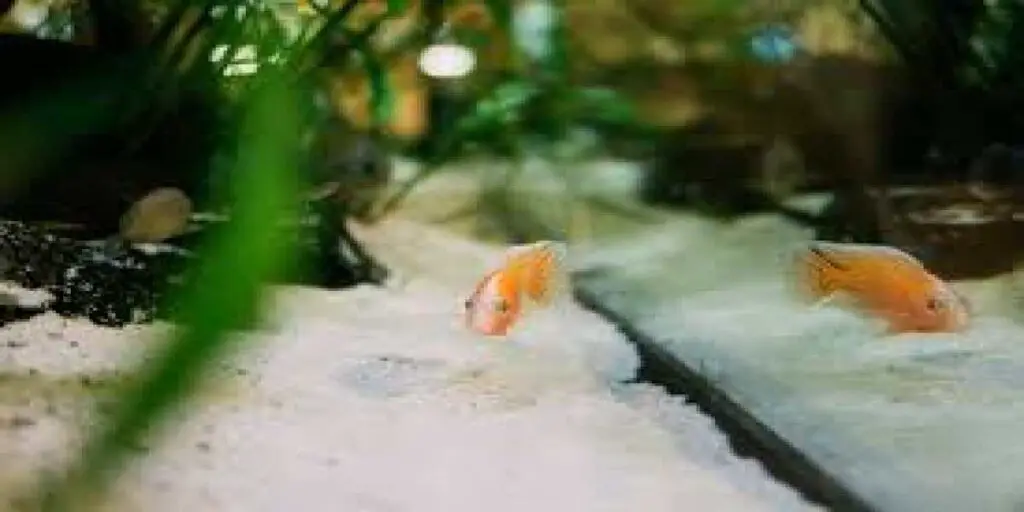After a water change, learn why your fish at top of tank after water change. Discover tips to ensure their health and comfort. Dive into fish care today.

Have you ever noticed your fish gathering at the water’s surface, seemingly gasping for air, after a routine water change in your aquarium? If so, you’re not alone. This common problem can be distressing for any fishkeeper, but fear not! In this article, we’ll delve into the reasons behind this behavior and equip you with the knowledge to address it effectively. So, let’s dive in and explore why your fish might be swimming at the top of the tank after a water change.
What Causes Fish to Swim at the Top of the Tank After a Water Change?
There are three primary factors that can lead to your fish exhibiting this behavior:
1. Low Oxygen Levels
One of the most common culprits behind fish congregating at the water’s surface is low oxygen levels. During a water change, several factors can contribute to decreased oxygen in your tank.
When introducing new water, it can be challenging to match its temperature and pH to the existing water, which can stress your fish. This stress leads to increased oxygen consumption, as your fish are working harder to adapt to the changing conditions.
Additionally, if the new water isn’t adequately conditioned, it may contain harmful chemicals, such as chlorine and chloramine, which can deplete oxygen levels in the tank. As fish gulp for air at the surface, it’s a clear sign that they’re struggling to get the oxygen they need from the water.
2. Water Poisoning
Improperly conditioned or untreated tap water is a potential source of harm to your aquatic companions. If you add untreated water to your tank during a water change, you risk introducing harmful chemicals that can poison your fish.
Symptoms of water poisoning can include gasping for air, difficulty breathing, and the instinctive tendency to swim at the top of the tank. It’s essential to be aware of this possibility and take steps to mitigate it during your routine maintenance.
3. Stress
Even when water changes are carried out correctly, they can still induce stress in your fish. Fish are creatures of habit and thrive in stable environments. The disruption caused by a water change can be stressful, leading to behaviors like swimming at the top of the tank, hiding, or even lethargy.
Now that we’ve identified the root causes let’s explore how to address this issue effectively.
How to Fix the Problem
Resolving the problem of fish swimming at the top of the tank after a water change involves a few practical steps:
1. Testing the Water
Start by testing your aquarium’s water parameters regularly. This includes monitoring levels of ammonia, nitrite, nitrate, pH, temperature, hardness, and alkalinity. These parameters should align with the requirements of your specific fish species. If any of these parameters fall outside the acceptable range, take steps to correct them before proceeding with a water change.
2. Making Small Water Changes
When it comes to water changes, gradual is the way to go. Instead of changing a large portion of the water abruptly, aim for a 20-25% water change at a time. This gentle approach minimizes stress on your fish and allows them to adapt more comfortably to the changing conditions.
3. Adding an Air Pump
If you suspect that low oxygen levels are contributing to your fish’s surface behavior, consider adding an air pump and airstone to your aquarium. This simple addition promotes increased surface agitation, facilitating better oxygen exchange between the water and the atmosphere. Be cautious not to create overly strong currents, as this can stress certain fish species.
4. Reducing Stress in Fish
Reducing stress during water changes is essential for maintaining the well-being of your fish. Here are some strategies to help minimize stress:
a. Use a Water Conditioner: Always treat tap water with a quality aquarium water conditioner before adding it to your tank. This neutralizes harmful chemicals like chlorine and chloramine, making the water safer for your fish.
b. Maintain a Consistent Temperature: Match the temperature of the new water as closely as possible to your aquarium’s existing water. Using a reliable aquarium thermometer will help you achieve this precision.
c. Be Gentle: When adding new water, pour it in slowly and direct it at a surface (like a plate or saucer) to disperse the flow gently. This minimizes disturbance in the tank and reduces stress on your fish.
d. Dim the Lights: Turn off or reduce the intensity of the aquarium lights during the water change. Sudden, bright light changes can add to your fish’s stress.
e. Avoid Overcrowding: Ensure that your aquarium is not overcrowded, as this can contribute to stress. Follow appropriate stocking guidelines for your fish species and tank size.
You May Also Like:
- Is 30% Water Change Too Much? (Best Guide)
- Are Weekly Water Changes Necessary? (Best Guide)
- Can You Put Oysters In A Reef Tank? Best 5 Benefits
Conclusion
In conclusion, fish swimming at the top of the tank after a water change can be a cause for concern, but it’s a problem that can be solved with the right knowledge and actions. By testing your water parameters, making gradual water changes, considering the use of an air pump, and minimizing stress during water changes, you can create a healthier and more comfortable environment for your aquatic companions.
